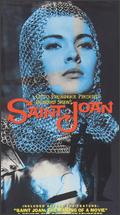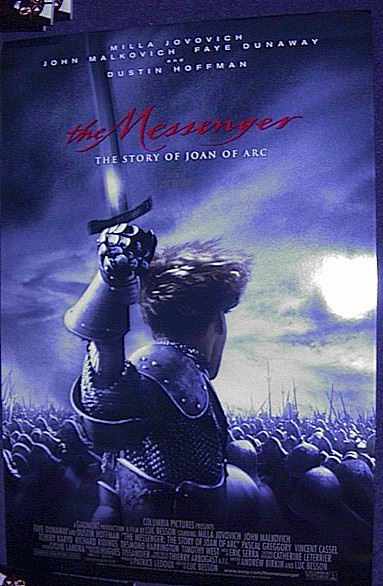Essay on Joan
Lindau Gospel
Images of the Maid
Links
Home
Saint Joan of Arc
Joan of Arc is a name that brings out many emotions. When her name is spoken it inspires hope, it strengthens courage; fosters anger, and it draws hatred. Joan of Arc was a name that was meant to be forgotten and wiped from existence, yet like her heart which did not burn in the fire, her memory has withstood the tests of time and she is respected today as one of the most amazing human beings who ever lived. Obviously, then, Joan has been translated to film, time and time again, and yet so many times misrepresented. With so much documentation on Joan’s life available, one might ask why her story has not been done justice on the silver screen? The answer is time. When a film is made, it tends to tell not only a story about robots or superheroes or historical heroes, but it tells a tale about the time period, or rather, about how the director/media wanted to use Joan (or misuse her). Joan has become a symbol over time in many ways. Sometimes she is presented as an inspirational figure for women during times of war: however, with the acceptance of female soldiers, the need for Joan as a role model diminished. As time passed, film makers were not concerned with the magnificent feats that Joan reached, but more so with her mental state.
A film on Joan was released in 1957, Saint Joan, directed by Otto Preminger. He decided to cast an unknown actress for the role of Joan: “A public search for Joan of Arc is, first and foremost, a marketing ploy. The discourse that surrounds these quests for the perfect girl to embody Joan, however, raises questions about the cultural meaning Joan of Arc in relation to notions of femininity and performance” (Blaetz 157). Otto Preminger wanted to cast a “pure” and “uncorrupted” girl for the role of Joan, and in fact he did not allow the seventeen-year-old Jean Seberg who was hired after a public search of over 14,000 aspirants to converse with the better known actors who worked with her in the movie in fear of her being “corrupted.” Otto did not want his Jean to learn how to act or to relax with her fellow actors in between scenes and see their husks peeled away while they behaved like normal sinful people. His Joan had to be real. His Joan had to be perfect.

Based on G.B. Shaw’s stage play, the movie did not cast blame on anyone; it represents all the characters as acting with conviction, according to the system in which they believed. Joan is represented as unwavering, courageous, and faithful, yet not as a model for emulation: “If she had been old enough to know the effect she was producing on the men whom she humiliated by being right when they were wrong, and learned to flatter and manage them, she might have lived as long as Queen Elizabeth” (Shaw 4). Shaw brings up a very valuable point about Joan’s obliviousness to the irritation she was generating by always being right and making sure the men in high positions around her knew so. The character of Dunois, who is Joan’s ally in the French army, says, “No, no, my girl: if you delivered me from fear I should be a good knight for a story book, but a very bad commander of the army” (Shaw 91). It appears that Otto Preminger wanted his Joan to be a role model for all women. Saint Joan was the last film about Joan of Arc before the Vietnam war.
Joan was used by the United States for war purposes multiple times.

For example, this image was used during World War I: Since women combatants were not allowed until the Persian Gulf War, it was common for images like these to surface during both World Wars. As Robin Blaetz has pointed out: “The domestication and infantilization that characterized representations of Joan of Arc after World War II simply became irrelevant as women armed themselves for battle” (Blaetz 182). This is a logical observation, for if a woman could go to battle, then why would she need to look at these images of Joan depicted as a stay-at-home war supporter…she is a soldier now.
The latest film about Joan is The Messenger (1999) This movie practically abandons the issue of women in war to focus on Joan’s psychological state and her supernatural visions. Some issues arise as to why this would be the focus, such as perhaps the director felt that it was so remarkable that a woman, a nineteen year old one at that, could take such command in her time, and her victories be remembered for hundreds of years, that they felt perhaps something was wrong with her rather than special.

In The Messenger, directed by Luc Besson – a French film director whose films are made in the “surface is more valued than content” style. Joan is represented as a rebellious, sacrilegious, deluded, short-tempered and argumentative teenager. The film did very poorly at the box office. Joan’s ‘voices’ are through creative liberty all lumped together into one voice of “the conscience” and it is never clear whether or not her voices are divine or she is suffering from some sort of psychological disorder. The director’s opinion of Joan is this:
If she wanted to be a good Christian, a good person...even if her motivation was good, to have her country free, it was wrong to participate in the massacres. 'Thou shalt not kill' – that’s a commandment (Price).
However, there is no record that Joan of Arc ever killed anyone herself. Actually according to the JoanNet website, Luc Besson, the director, killed more people in the making of his movie (1 stunt extra) than Joan did during her entire career. On a happier note, Milla Jovovich who was cast as Joan, divorced her husband who happened to be Luc Besson shortly after the film was completed.
It is unfortunate that with all the technology and resources that the film industry has access to today that a completely accurate movie about Saint Joan of Arc has yet to be produced. Some director wants to always put his own spin on the story, or push his own moral lesson rather than just tell the story correctly. It is not entirely respectful of Joan to not have faith that one day someone will decide to make a film about her and do her epic tale justice. Maybe that someone is Mel Gibson.

Works Cited
Blaetz, Robin. Visions of the Maid. Charlottesville and London: University Press of Virginia, 2001.
JoanNet. Patrick Price. 23 January 2004. 14 April 2004.
Saint Joan. Dir. Otto Preminger. Starring John Gielgud, Jean Seberg, Richard Widmark. USA: United Artists, 1957.
Shaw, G.B. Saint Joan. London: Penguin Books, 1946.